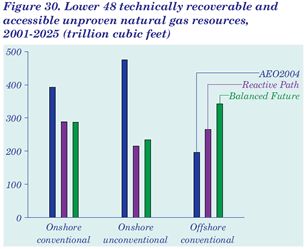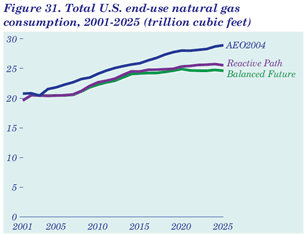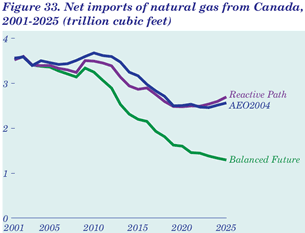|
Issues In Focus. Natural Gas Markets: Comparison of AEO2004 and National Petroleum Council Projections The National Petroleum Council (NPC) recently released the first volume of a report describing two possible projections for U.S. natural gas market conditions through 2025 [63]. The NPC’s Reactive Path and Balanced Future scenarios are compared here with the AEO2004 reference case. Unlike the AEO2004 reference case, which assumes the continuation of current laws, policies, regulations, technology trends, and productivity trends through 2025, the two NPC scenarios assume the adoption of new policies, which “move beyond the status quo.” Of the two NPC scenarios, the design of the Reactive Path is closer to that of the AEO2004 reference case than is the design of the Balanced Future scenario.
This discussion focuses on a “global” comparison of the NPC and AEO2004 projections and assumptions, because the two reports categorize and aggregate energy market data differently. Although the NPC report and AEO2004 begin from similar estimates of total end-use gas consumption in 2002 (20.5 and 20.8 trillion cubic feet, respectively), the NPC study shows 0.9 trillion cubic feet more gas consumption in the industrial sector and 1.1 trillion cubic feet less gas consumption in the electric power sector in 2002. This accounting difference can be attributed in part to the fact that EIA has revised its data collection and reporting systems for industrial electricity generation, or CHP. In addition, new industrial CHP is reported by the NPC in the electric power sector, whereas historical CHP consumption is counted in the industrial sector. These accounting complications preclude direct comparison of the AEO2004 and NPC projections for industrial and electric power sector natural gasconsumption. Table 14 provides an overview of the AEO2004 and NPC 2002 data and projections for 2010 and 2025. The primary similarities between AEO2004 and the NPC projections include:
The primary differences between the AEO2004 and NPC projection scenarios include:
Forecast Assumptions Both the NPC Reactive Path scenario and the AEO2004 reference case assume that U.S. GDP will grow by 3 percent per year through 2025. For U.S. electricity generation, AEO2004 projects 1.8-percent average annual growth from 2002 through 2025, while the NPC Reactive Path and Balanced Future scenarios project average annual growth of 2.1 percent and 2.0 percent, respectively. AEO2004 projects 2.6-percent annual growth in industrial output, compared with 1.1 percent in the NPC scenarios. AEO2004 and the NPC scenarios expect different future oil prices. Both the NPC scenarios assume that U.S. refiner crude oil acquisition prices will decline to $18 per barrel in 2005 (2002 dollars) and continue at that level through 2025. AEO2004 assumes that the refiner acquisition price for imported crude oil will decline to $23.30 per barrel in 2005 and increase slowly to $27.00 per barrel in 2025 (2002 dollars). The NPC Reactive Path scenario differs from AEO2004 in projecting the size and composition of the undiscovered lower 48 natural gas resource base (Figure 30). Generally, AEO2004 assumes a larger resource (1,065 trillion cubic feet) than the Reactive Path and Balanced Future scenarios (770 and 874 trillion cubic feet, respectively) [66]. AEO2004 assumes more onshore conventional resources (392 trillion cubic feet) than the Reactive Path and Balanced Future scenarios (289 and 297 trillion cubic feet) and more unconventional gas resources (475 trillion cubic feet) than the Reactive Path and Balanced Future scenarios (216 and 234 trillion cubic feet). The Reactive Path and Balanced Future scenarios assume more undiscovered offshore gas resources (265 and 343 trillion cubic feet) than AEO2004 (197 trillion cubic feet). Accordingly, AEO2004 projects proportionately more onshore gas production at market-clearing prices than do the NPC scenarios. The AEO2004 and NPC gas resource assumptions differ most significantly with respect to the additional gas resources expected to be discovered in existing onshore conventional oil and gas fields (identified as “field appreciation,” “reserve growth,” and “inferred resources”). The AEO2004 assumption is based on USGS resource estimates, which result in an inferred onshore conventional gas resource base of 292 trillion cubic feet. The NPC scenarios are based on a different methodology, which results in 164 trillion cubic feet of inferred resources. Because inferred gas resources are the least expensive incremental source of domestic natural gas supply, the difference in assumptions is responsible in part for the different projections of onshore conventional gas production. Consumption The AEO2004 and NPC projections differ with respect to future levels of natural gas consumption but largely agree on the mix of future supplies. In 2025, AEO2004 projects total U.S. gas consumption of 31.4 trillion cubic feet, compared with 27.6 trillion cubic feet in the Reactive Path scenario and 26.6 trillion cubic feet in the Balanced Future scenario. Total U.S. consumption of natural gas includes pipeline fuel and production area lease and plant fuel, which is natural gas consumed in production and transportation to end-use markets.
In 2025, the projections for total end-use gas consumption (excluding pipeline, lease, and plant fuel) are 28.9 trillion cubic feet in AEO2004, 25.5 trillion cubic feet in the Reactive Path, and 24.6 trillion cubic feet in the Balanced Future scenario (Figure 31). In the AEO2004 reference case, end-use gas consumption is projected to grow by 1.4 percent per year from 2002 to 2025, compared with 1.0 percent in the Reactive Path and 0.8 percent in the Balanced Future scenario. The differences between the AEO2004 reference case and the NPC scenarios result largely from different projections for industrial sector natural gas consumption, primarily as a result of the NPC’s lower projected growth rate for industrial production. Although NPC and AEO2004 employ different accounting methods for the treatment of CHP in the industrial sector, one method for comparing the NPC and AEO2004 industrial and electric power gas consumption projections is to account for the AEO2004 CHP projection results in the same manner as the NPC scenarios, namely, by allocating incremental CHP gas consumption after 2001 to the electric power sector (Table 15). Based on this reallocation, it is clear that the large difference between the AEO2004 and NPC end-use gas consumption projections is attributable primarily to significantly different expectations for growth in industrial natural gas consumption. In AEO2004, adjusted industrial gas consumption grows by 1.1 percent per year throughout the forecast, whereas the Reactive Path and Balanced Future scenarios project declines of 0.6 percent and 0.4 percent per year, respectively. In AEO2004, natural gas consumption for electric power generation (adjusted for CHP) grows by 2.3 percent per year, which is between the Reactive Path and Balanced Future projections of 2.7 percent and 2.1 percent per year, respectively. For residential and commercial end-use consumption, the AEO2004 and NPC projections are virtually identical throughout the forecast. In 2025, Henry Hub spot prices for natural gas are projected to be between $5 and $7 (2002 dollars) per million Btu in the Reactive Path scenario and between $3 and $5 per million Btu in the Balanced Future scenario, while end-use natural gas consumption in 2025 is 0.9 trillion cubic feet lower in the Balanced Future than in the Reactive Path scenario. The Balanced Future scenario projects less natural gas consumption despite significantly lower prices, because it assumes that future gas-consuming equipment (including gas-fired generating capacity) will have more flexibility to use other fuels and will be more fuel-efficient than assumed in the Reactive Path scenario. Supply In both the NPC study and AEO2004, domestic natural gas consumption is satisfied through both domestic gas production and net gas imports [67]. In all three scenarios, net imports are projected to grow at a faster rate than end-use gas consumption. AEO2004 projects average growth in net imports of 3.2 percent per year between 2002 and 2025; the Reactive Path and Balanced Future scenarios project average growth in net imports of 2.5 and 2.1 percent per year, respectively [68]. Although the AEO2004 and NPC end-use gas consumption levels in 2025 are significantly different, the relative proportions of domestic supply and net imports are similar. For 2025, both AEO2004 and the Reactive Path scenario project that net imports will provide 23 percent of domestic natural gas consumption, with the remaining 77 percent coming from domestic supply sources. The Balanced Future scenario projects corresponding proportions of 22 percent and 78 percent. Imports and Exports
Projected net imports of natural gas (pipeline and LNG) in AEO2004 are higher than in either of the NPC scenarios. The NPC developed detailed cost estimates for liquefaction, shipping, and regasification facilities and used those estimates to develop exogenous LNG scenario projections. The Balanced Future scenario assumes a more favorable LNG import policy than in the Reactive Path scenario. In the Balanced Future, net LNG imports are projected at 4.8 trillion cubic feet in 2025, compared with 3.9 trillion cubic feet in the Reactive Path scenario (Figure 32). AEO2004 projects LNG imports on the basis of a comparison between LNG delivery costs and projected natural gas prices. AEO2004 projects 4.8 trillion cubic feet of net LNG imports in 2025. Although the AEO2004 projection for net LNG imports in 2025 is almost identical to that in the Balanced Future scenario, in terms of percentage of total net imports, the 66-percent share projected for LNG imports in 2025 in AEO2004 is closer to the 62-percent share in the Reactive Path than to the 82-percent share in the Balanced Future scenario. Canada is the other major source of U.S. natural gas imports. In 2025, imports from Canada are projected to make up 35, 43, and 22 percent of total U.S. net imports in the AEO2004 reference case, NPC Reactive Path, and NPC Balanced Future scenario, respectively. In all the projections, net imports from Canada are projected to peak around 2009 and decline thereafter (Figure 33). AEO2004 projects 2.6 trillion cubic feet of net imports from Canada in 2025, compared with 2.7 and 1.3 trillion cubic feet in the Reactive Path and Balanced Future scenarios, respectively. Thus, in the NPC study, higher LNG imports are offset by lower imports from Canada. Both AEO2004 and the NPC scenarios project negligible quantities of net gas exports from the United States to Mexico in 2025, at 0.1 and 0.3 trillion cubic feet, respectively. Domestic Production In both the NPC and AEO2004 projections, natural gas imports increase more rapidly than consumption; thus, all three scenarios project slower growth in U.S. gas production than in consumption. The AEO2004 reference case projects 1.0-percent average annual growth in domestic natural gas production from 2002 to 2025, compared with 0.5 percent per year in the two NPC scenarios. The projections for total U.S. natural gas production in 2025 are 24.0, 20.9, and 20.8 trillion cubic feet in the AEO2004 reference case and the Reactive Path and Balanced Future scenarios, respectively (Figure 34). Periods of more rapid increases in U.S. natural gas production are projected for 2018-2020 in AEO2004 and 2013-2015 in the NPC scenarios, resulting from the advent of North Slope Alaska gas pipeline operations. The NPC Reactive Path and Balanced Future scenarios both assume that the Alaska gas pipeline will begin operation in 2013 with an initial capacity of 4 billion cubic feet per day. AEO2004 projects that the pipeline will begin operation in 2018 with a capacity of 3.9 billion cubic feet per day of dry gas, followed in 2023 by a 0.9 billion cubic foot expansion, for a total dry gas throughput capacity in 2025 of 4.8 billion cubic feet per day. AEO2004 projects total lower 48 production of 21.3 trillion cubic feet of natural gas in 2025, compared with 18.9 trillion cubic feet in the Reactive Path scenario and scenarios—only slightly higher than current production levels. AEO2004 projects offshore gas production similar to that in the NPC scenarios, but higher onshore gas production. Onshore gas production in AEO2004 is projected to be 76 percent of total lower 48 production in 2025, compared with 73 percent in the Reactive Path scenario and 69 percent in the Balanced Future scenario. As a result, AEO2004 projects 16.3 trillion cubic feet of lower 48 onshore gas production in 2025, compared with 13.7 and 13.0 trillion cubic feet in the Reactive Path and Balanced Future scenarios, respectively. In all three scenarios, lower 48 offshore production fluctuates because sufficient natural gas reserves must be discovered in an area to justify the construction of offshore platforms and pipelines. AEO2004 projects average offshore gas production of 5.0 trillion cubic feet per year from 2002 through 2025, compared with an average of 5.4 trillion cubic feet per year in the two NPC scenarios. The projections for cumulative lower 48 natural gas production from 2002 through 2025 are summarized in Table 16. AEO2004 projects 489 trillion cubic feet of production from the lower 48 gas resource base, proportionately more from onshore (75 percent) than offshore (25 percent). The Reactive Path and Balanced Future projections are similarly apportioned: 72 and 71 percent onshore and the remaining 28 and 29 percent offshore, respectively. The NPC Balanced Future scenario assumes increased access to Federal offshore areas and onshore lands, while the Reactive Path does not. Federal offshore access adds 79 trillion cubic feet to the offshore technically recoverable and accessible resource base, and greater Federal lands access adds 35 trillion cubic feet to the onshore technically recoverable and accessible gas resource base (see Figure 30) [69]. The Balanced Future scenario projects 0.8 trillion cubic feet more cumulative offshore gas production than in the Reactive Path scenario but produces considerably less of the total accessible offshore resource base (Table 17). In the Balanced Future scenario, considerably more gas is produced from regions of the offshore Atlantic and Pacific that are currently not accessible. In 2025, the incremental Atlantic and Pacific offshore gas production is projected to be just over 752 billion cubic feet. Most of the incremental offshore gas production that results from increased Federal access occurs in the offshore Atlantic, where gas production is projected to reach 608 billion cubic feet in 2025. The impact of greater Federal access is not apparent until after 2010, because considerable delays are expected to be encountered in leasing, seismic exploration, drilling, and development. AEO2004 assumes a much larger volume of onshore gas resources, both conventional and unconventional, than do the NPC scenarios (see Figure 30). Also, AEO2004 and the NPC scenarios project similar levels of offshore gas production, even though AEO2004 projects considerably more total production than in the NPC scenarios. As a consequence, most of the difference between the AEO2004 and NPC gas production projections is attributable to their different projections for onshore natural gas production. The AEO2004 projection for unconventional natural gas production is consistently higher than the NPC projections [70]. In 2025, AEO2004 projects 9.2 trillion cubic feet of unconventional gas production, compared with the Reactive Path and Balanced Future projections of 7.9 and 7.3 trillion cubic feet (Figure 35). Although the NPC scenario projections for unconventional gas production are quite different in 2025, they are almost identical up to 2020. For lower 48 onshore conventional production, AEO2004 and the NPC scenarios again show considerable differences in their projections for both nonassociated and associated natural gas. AEO2004 projects a slow decline in nonassociated conventional gas production throughout the forecast, to 5.9 trillion cubic feet in 2025. The Reactive Path and Balanced Future scenarios project more rapid declines to 4.2 and 4.1 trillion cubic feet in 2025, respectively. In all three scenarios, unconventional gas production increases while nonassociated conventional gas production does not, indicating that unconventional gas is the least expensive incremental source of lower 48 onshore natural gas production. Lower 48 onshore production of associated-dissolved conventional gas declines throughout the AEO2004 projection, to 1.2 trillion cubic feet in 2025. In the two NPC scenarios, associated-dissolved conventional gas production declines until 2005, then rises from 1.3 trillion cubic feet in 2005 to 1.5 trillion cubic feet in 2025. Associated-dissolved gas production depends directly on crude oil production, and all three scenarios project declining onshore production of crude oil throughout the forecast period. The NPC scenarios, however, project a slower decline than in the AEO2004 reference case. In addition, the NPC scenarios project more natural gas production per barrel of oil produced in 2025 than does AEO2004, which, in combination with NPC’s higher projections for oil production, results in the only instance of a higher projection for a component of domestic natural gas supply in 2025 in the NPC forecasts than in AEO2004.
Released: January 2004 |
||||||||||||||||||||||||||||||||||||||||||||||||||||||||||||||||||||||||||||||||||||||||||||||||||||||||||||||||||||||||||||||||||||||||||||||||||||||||||||||||||||||||||||||||||||||||||||||||||||||||||||||||||||||||||||||||||||||||||||||||||||||||||||||||||||||||||||||||||||||||||||||||||||||||||||||||||||||||||||||||||||||||||||||||||||||||||||||||||||||||||||||||||||||||||






